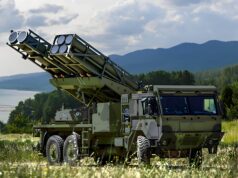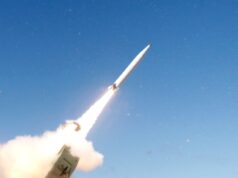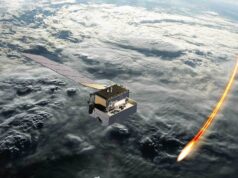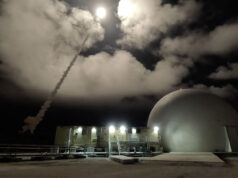The US State Department has approved the sale of three E-2D Advanced Hawkeye aircraft and associated equipment to France.
The Defense Security Cooperation Agency notice can be found here.
The Government of France has requested:
- three (3) E-2D Advanced Hawkeye aircraft;
- ten (10) T-56-427A engines (6 installed and 4 spares);
- three (3) AN/APY-9 radar assemblies;
- four (4) AN/ALQ-217 electronic support measure systems (3 installed and 1 spare);
- three (3) AN/AYK-27 Integrated Navigation Channels and Display Systems;
- five (5) Link-16 (MIDS-JTRS) Communications Systems (3 installed and 2 spares);
- ten (10) Embedded GPS/INS (EGI) Devices (6 installed and 4 spares);
- four (4) AN/APX-122(A) and AN/APX-123(A) Identification, Friend or Foe systems (3 installed and 1 spare) and
- one (1) Joint Mission Planning System.
Also included are Common Systems Integration Laboratories with/Test Equipment, one in Melbourne, FL, and the other in France; air and ground crew equipment; support equipment; spare and repair parts; publications and technical documentation; transportation; training and training equipment; U.S. Government and contractor logistics, engineering, and technical support services; and other related elements of logistics and program support.
The total estimated program cost is $2 billion.
“The E-2D aircraft will continue and expand French naval aviation capabilities and maintain interoperability with U.S. naval forces. As a current E-2C operator, France will have no difficulty absorbing this equipment and support into its armed forces.”
It is important to note that this notice of a potential sale is required by U.S. law and does not mean the sale has been concluded.










Will the original E2C’s be replaced or supplement the E2D fleet?
Replaced.
The E2D will replace the E2C on the carrier. Not sure what France has in mind for the E2C. Since they are not that old (1998 to 2004), they could be transfered to a land base to operate from. Bit a early to scrap them, and i am not sure what US policy is about selling them to another country.
There will be a drone, which can be launched from QE, that will be able to perform this role.
Are you talking speculatively or is this in development?
First I hear of this. I have heard of refueling drone for US carriers in development as well as loyal wingman concepts, but not any awacs. There are some light heli drones for frigates, just flir and limited radar and weapons, but nothing close to AWACS.
What is the name of this project, who is developing it and what is the timeframe?
I do apologize, I was speculating, will try to be clearer in future!
I got what you meant Andy. I agree.
I much think you need a catapult to launch drones from an aircraft carrier. Maybe mini catapults to launch smaller drones is feasible.
If we’re fitting mini catapults we might aswell go the whole 9 yards and fit big ones for jets, too. Seeing as the cost difference wouldn’t be too large.
“Seeing as the cost difference wouldn’t be to large”? You are joking yes?
Well, you’d be paying for the training and fitting costs regardless. And the logistical chain and hiring new specialists for the upkeep of the catapults. The only thing you’d pay less for is a shorter catapult, which I can’t imagine would see that much of a price difference when you factor in the cost of learning the skills to maintain and operate the catapults.
Well, they can’t fit traditional steam catapult, since it’s a gas turbine engine powered ship.We have purchased the F35B which are not CATOBAR Aircraft, so we would have to procure the F35C or other aircraft. The pilots would need to retrain which will be expensive and so on. So EMALS, the electric catapult system was (in 2010) proposed to be added. But it would send the cost of the QE up by £3B and PoW by £2B (Therby doubling the cost of each)
Electromagnetic Aircraft Launch System/Advanced Arresting Gear (EMALS/AAG). The EMALS long lead sub-assemblies include:
Energy Storage System,
Power Conditioning System, and Launch Control System.
The AAG includes: Power Conditioning, Energy Absorption Subsystems, Shock Absorbers, and Drive Fairleads.
Also proposed are other items for Aircraft Launch and Recovery Equipment, spare and repair parts, support equipment, personnel training and training equipment, publications and technical documentation, software support, U.S. Government and contractor engineering, technical, and logistics support services, and all other related elements of program support. Take that into account and the price is just not worth it.
It you could have a side launcher rail launch system so no cutting into the expensive deck ect.
And arestor wire, but a mini side lunched Rail system for a drone would be great to launch awacs drones in future, and a simple recovery system of some sort a wire would just get in way of f35 ops. Vertical takeoff and recovery awacs drone would probably be the best.
Do you have a crystal ball? The RN needs a credible AEW aircraft, not a helo for their new CVs.
Their helos will do for now along with our destroyers Sampson and frigates radars., and the f35s radar and situational awareness is second to none and act as a mini awacs platform.
The JSDF has been buying them for several years now. They have a large fleet of the C models to replace.
https://www.airforce-technology.com/news/jasdfs-e-2d-advanced-hawkeye-conducts-first-flight/
Cheers
The French Government have finally stated they are going to replace their Charles de Gaulle with a ship just over double the tonnage in the 70,000t range and to be in service by 2038. The CDG will be 40 years old by this stage. The Project name is called PANG, though I can’t find what the acronym stands for? What has been stated though is that it will have the US EMALS and AAG. The ship will initially operate the Rafale M, with the next generation fighter replacing it. It will also operate drones and Hawkeye AEW aircraft plus helicopters. The French Navy are looking at a drone requirement that can do air to air refuelling. There have been a number of new drawings of PANG, one is a development of a QE class carrier with two islands, some others show a ship with just the one island. There is still some debate over whether it should be nuclear or conventionally powered, with nuclear being the favourite. It may be something based on the QE design using the hull, but with a single island as there is no longer a need for the two separate exhaust stacks.
President Macron has the final decision to give the go/no go to the PANG program. He will also have to decide whether the PANG program is limited to a single replacement of the sole Charles de Gaulle nuclear-powered aircraft carrier or if the program calls for the construction of two carriers. The French Navy has stated that it favours in order of preference:
1. two nuclear-powered aircraft carriers,
2. two aircraft carriers with conventional propulsion,
3. a single nuclear-powered aircraft carrier,
4. a single aircraft carrier with conventional propulsion.
I think France will definitely go-ahead with at least one new carrier, but because of who Macron is, I can see him going for two carriers. As it can’t be seen that the French don’t match the perfidious British in Naval carrier power.
This sort of coincides with Japan upgrading their helicopter “destroyer” Izumo to be a “multi-role operation vessel” that can operate F35Bs. The Japanese opposition parties have argued that the upgrade exceeds the scope of military power the country is entitled to, under the war-renouncing Constitution. Since World War II, Japan has pledged not to own “offensive air carriers,” saying it would be beyond its exclusively defence-oriented posture. Japan’s defence ministry insists they would not regularly carry fixed-wing fighters and would also be used for missions including anti-submarine and rescue operations.
China’s emerging military presence in the Western Pacific, with forces that now include the aircraft carrier Liaoning and Shandong, which carry the J-15 fighters, is a key reason Japan plans to upgrade the Izumo-class ships, to allow them to carry F-35Bs. A senior Defence Ministry official admitted that as the Chinese navy has now frequently made incursions into the Pacific Ocean by passing through the Miyako Strait, i.e. crossing the waters between Okinawa and Miyako Island south of Japan, upgrading the Izumo has become a priority.
The Japanese are clearly worried from China’s rapid advancement and build up of naval forces. In Japan, there are a number of new “plastic” model kits available of the Izumo with a full complement of F35B on board. There are also models of a new “proper” carrier, showing an angled deck, catapults and a futuristic next gen aircraft. Could these models reflect what Japan may be looking at producing soon? Especially if China gets its next design of carriers the Type 003 (85,000t) and 004 (>85,000t) constructed and operational.
I posted quite a bit on the Izumo upgrade in the Japanese F35 buy thread but here’s an interesting article. It’s supposedly a leaked document from General Atomics with a proposal to fully convert the Izumo into a light CATOBAR carrier. I’m sure it could be done if there is enough funding but I’m also sure it would be more practical to build it from scratch.
https://www.militaryq.com/2019/11/29/leaked-photo-general-atomics-offers-possible-japenese-helicopter-destroyer-conversion-into-aircraft-carrier/
Cheers
https://i0.wp.com/www.militaryq.com/wp-content/uploads/2019/11/2606874_original-scaled.jpg?fit=640%2C480&ssl=1
Nah, don’t buy it. Japan have said the modifications to the ship will be done in stages and that it will operate F35Bs, starting with heatproofing the deck, then adding a ski ramp sometime later.
If the ship was going to be CATOBAR, then they would have bought the F35C. Maybe in the future with a newer purpose built carrier. Converting the Izumo to a STOVL is the quickest and easiest method of giving their Navy organic air power.
PANG= Porte Avions de Nouvelle Generation
Cheers
I doubt Macron will be in power to make the decision and if he is, its pretty irrelevant what the UK has done. France is more likely to be influenced by EU defence policy and if the EU is getting its act together regarding greater integration militarily, then I suspect France WON’T go for 2 carriers by itself but as part of a European carrier force. Of the EU navies, France is the biggest and most capable and would certainly have one, but I wonder if the Italians/Spanish and even Germans could resource a carrier between them. France won’t pay for 2 nuclear powered carriers alone that’s for sure.
With China becoming more and more assertive, it is understandable that the japanese need to react. South Korea is also looking at building carriers (requirements still in discussion ie VTOL vs CAT etc..) so behind Japan in timing, but just as worried about China. There will be a lot carriers in the Pacific in the not so distant future.
Indeed, Indian strategy to focus on carriers as well to provide a second strike capability in the event of a devastating Chinese first strike on their airbases.